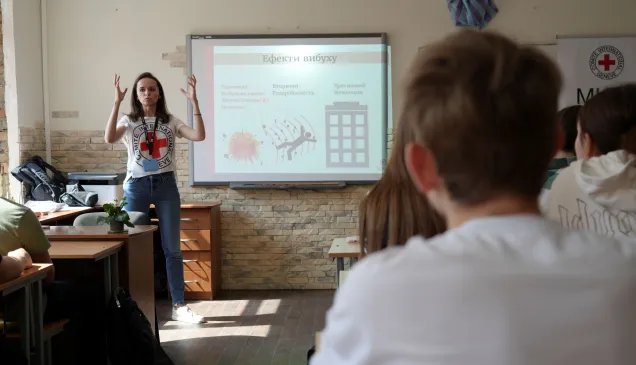Madame President, Excellencies, distinguished delegates, ladies, and gentlemen,
This statement on behalf of the International Committee of the Red Cross (ICRC) and the International Federation of Red Cross and Red Crescent Societies (IFRC), with member National Societies in 191 countries is read by representatives from the Iraqi Red Crescent, the Lithuanian Red Cross and the Irish Red Cross. We are grateful for the opportunity to address this Meeting of States that have committed themselves in the Convention’s preamble “to put an end for all time to the suffering and casualties caused by cluster munitions”. Red Cross and Red Crescent volunteers and staff in countries contaminated by cluster munitions see the indiscriminate effects of these horrific weapons daily while assisting victims and working to promote risk reduction and safer behavior.
They know that a humanitarian response can never redeem the appalling suffering cluster munitions cause. The core norm of this Convention is prevention through the prohibition of cluster munitions – based on their devastating and indiscriminate impact on the lives of people and communities wherever they are used. In this regard we welcome that South Sudan and Nigeria joined the Convention last year and we urge signatories and all other non-party States to do so urgently. We call on State Parties to further promote adherence to the Convention by non-party States as per their obligation under article 21 and further strengthen the stigma against these weapons.
Although the Convention has been highly successful, States Parties need to do far more to promote and defend its core norms, particularly in the current context of international tensions. As the ICRC President recently stated: “International Humanitarian Law is not made for the hopeful days of peacetime. It is made for humanity’s darkest days, when armed conflict rages and people are in grave danger”.
Today the Convention is facing a major challenge, as the pace of ratifications has slowed in recent years and a State Party has initiated the process to withdraw from the Convention. The ICRC and the IFRC deeply regret this decision and urge the State concerned to revoke its withdrawal before it takes effect. Let us be clear – a withdrawal from a key international humanitarian law treaty will affect not only one State but all States Parties and signatories and will tear at the fabric of international humanitarian law.
At this crucial moment sixteen years after the adoption of the Convention, it is imperative to recall WHY this Convention was essential to end the human suffering caused by cluster munitions once and for all. First and foremost, cluster munitions are area weapons that cause destruction over vast areas, entailing a very high risk of indiscriminate effects on civilians and civilian objects, in particular when used in populated areas. Military experts and post-action reviews by some of the world’s major military forces have lamented the imprecision of sub-munitions and the inability to control external factors that lead to submunitions landing in areas beyond the envisioned target, labelling them “relics” of the Cold War. In some contexts, the widespread contamination by unexploded submunitions has been noted to be dangerous for the conduct of military operations by one’s own forces.
This Convention has been an essential instrument because of the consistently tragic impact for civilians and their communities virtually every time cluster munitions have been used. The history of cluster munitions since their first use in 1945 has been one of post-use civilian casualties as civilians attempt to rebuild their lives. A story of people killed or maimed as they sort through the rubble of their destroyed homes, of farmers killed as they try to till or harvest their land, of children – often in groups - who are blown apart as they play with colorful and attractive submunition canisters and of clearance personnel killed and maimed as they toil for months or years to remove the life-threatening contamination.
This history of failed submunitions - which result in the vast majority of casualties occurring after use - has been consistent over decades. According to leading experts their failure rates are typically higher than manufacturers claim and can range from 5 to 40% depending on the type and context of use. As submunitions can be distributed by the tens of thousands in a few hours, and millions in a few days, the levels of contamination are often astounding, and highly lethal for civilians. Most cluster munition stockpiles today consist of ageing submunitions, often dating back decades to the Cold War period, which can further increase their failure rates.
States Parties today stand at a crossroads. Never before has a State withdrawn from a global IHL treaty prohibiting an entire category of weapons. Together with the 1949 Geneva Conventions and their Additional protocols of 1977, these are the ramparts that humanity has built up over generations to protect itself from the brutalities of war and some of the most horrific weapons ever invented. They were rooted not in idealism but in the grim realities of armed conflict and yet they successfully balanced military needs with the necessities of humanity.
It is up to you the States Parties and the broader Convention community, this week, to defend and promote the norms of this Convention. You can do this by sparing no effort to prevent any withdrawal from the Convention and responding strongly to any step in such a highly regrettable direction; by reaffirming the value of its norms particularly in times of tension; and by committing collectively to do far more to condemn any use of cluster munitions by anyone under any circumstances and to promote adherence to the Treaty by non-party States. The stakes of what is decided here this week are high, for this Convention, for the fabric of international humanitarian law and for our future shared humanity.
I thank you for your attention.




